When talking about the FX-8350 processor,
we came to the conclusion that Piledriver microarchitecture didn’t improve much
the energy-efficiency of the Socket AM3+ processors. AMD’s products which were created
with 32 nm process are still more power-consuming than the 22 nm rivals.
However, Vishera modifications that were reviewed work at lower clock
frequencies and have fewer cores, so they may be more energy-efficient than the
leading processor. Especially, as six-core and quad-core modifications have 95W
maximum TDP instead of 125W TDP in their “fully-equipped” siblings.
To understand more about the power
consumption of all contemporary processors in the new AMD FX series, we carried
out a round of specific tests. The new digital PSU from Corsair – AX1200i –
allowed monitoring electrical power that was consumed and produced, which we
used positively through our power consumption tests. The graphs below (except
for any other requirements) show the full power draw of the computer (with no
monitor) measured after having the power supply. It is the total power
consumption of all system components. The PSU's efficiency didn’t count. The
CPUs were loaded by operating the 64-bit version of LinX 0.6.4-AVX utility. Furthermore,
we enabled Turbo mode and all power-saving technologies to correctly measure
computer's power consumption in idle mode: C1E, C6, Enhanced Intel SpeedStep
and AMD Cool ’n’ Quiet.
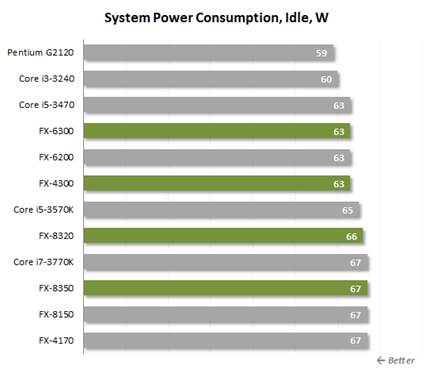
Idle
mode
In idle mode all processors and platforms
consumed about the same power. In idle mode, any processor would switch to
special power-saving states, where the power consumption was very low – just a
few watts. In this case the power consumption of other system components and
the efficiency of the voltage regulator circuitry on the mainboard became more crucial
and they partially covered the processor’s pure power consumption.

1
thread
In case of single-threaded load, things
started getting worse for AMD processors. The fastest and most energy-consuming
LGA 1155 Core i7-3770K consumed remarkably less power than the most
energy-efficient AMD FX product. Concurrently, AMD processors worked slower
under this kind of load than Intel CPUs. Well, Vishera generation doesn’t waste
the energy the way Zambezi processors did, but there is still no clearly
recognizable sign of a change in quality.

100%
load
The situation didn’t become better with AMD
FX power consumption under multi-threaded load. FX-8350 turned out the most
power-consuming CPU in our test. It consumed 4% more power than FX-8150 under
maximum load and was 2/3 more power-hungry than Intel Core i7-3770K. Other
members of the FX series on Vishera design worked a little better in comparison
with their predecessors, but they weren’t still on par with any competitive
offerings. At the same time, I have to say that FX-6300 and FX-4300 with 95W
TDP looked much better than the background of all other Socket AM3+ processors.
We also tested the old Core i5 processors created with 32nm process, at that
time the new dual-module quad-core AMD processor could have been comparable
against them in power consumption. Although with reference to performance, this
comparison didn’t make sense.
In other words, it seems that contemporary
AMD processors hopelessly fall behind their Intel competitors, regarding performance-per-watt.
While in performance tests top eight-core Vishera processors could sometimes win
Intel’s quad-core Ivy Bridge CPUs, all illusions disappeared into thin air the
minute when it got down due to power consumption.
Overclocking
AMD FX processor series is thought as overclocked
product. All these processors have unlocked frequency multipliers, which mean
supporting simple overclocking. Note that both Zambezi and Vishera have
sufficient frequency potential for a considerable performance boost, which, though,
will come with serious increase in power consumption. Nonetheless, overclocking
is an important competitive advantage of CPUs in the FX series. Intel
processors can only be easily overclocked if they are in the price range of
$220 and above. For AMD, they support over-clockers on a budget, which is one
of the basic reasons why Socket AM3+ platform became more and more popular.
Saying about the Piledriver
microarchitecture, AMD focused on that it increased frequency potential. Thus,
we were quite optimistic about that Vishera processors will be more interesting
to overclock than their predecessors, which could only reach as far as
averagely 4.6GHz with air-cooler. Though, right from the start it is clear that
the new processors didn’t have such improvement – the first FX-8350 processor
we received in our lab was overclocked only to 4.7 GHz.
However, it is unfair to judge the overclocking
potential of an entire series just by one single processor, so we decided to
check out the overclock-ability of all four Vishera products. The purpose
wasn’t to get a overclocking records, but to determine the frequency, at which
new FX processors is able to continuously run in 24/7 mode without losing
stability. Hence, we set the processor Vcore at 1.55V, according to advices
from AMD engineers. The cooling system used was NZXT Havik 140. Then, we tested
the overclocked system’s stability by executing OCCT 4.3.2 utility (30 minutes
in Large Data Set mode).
First of all, we checked our FX-8350
processor once again. We hoped to get a better result than the initial 4.7GHz.
However, we have already tested a few other FX-8350 samples since then and none
of them was better. Hence, it looked like 4.7GHz is a typical overclocking limit
for a flagship AMD FX processor equipped with an air cooler.
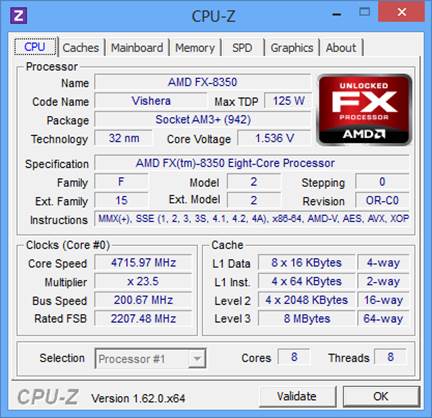
Overclocking
AMD FX-8350
People may think that the junior processor
models are not manufactured with the best semiconductor dies that is why their
overclocking potential is usually much lower. Actually, this is a pretty rare case,
and our FX-8320 unit proved that. It easily reached the 4.6GHz mark, which was
only 100 MHz lower than the results received from its more expensive
counterpart.
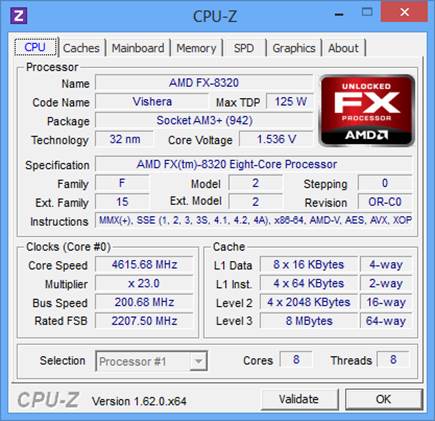
FX-8320
easily reached the 4.6GHz mark
The six-core FX-6300, which features one
disabled dual-core module, overclocked practically as well as the “completed”
Vishera processors. It remained perfectly stable at the maximum 4.7GHz
frequency.
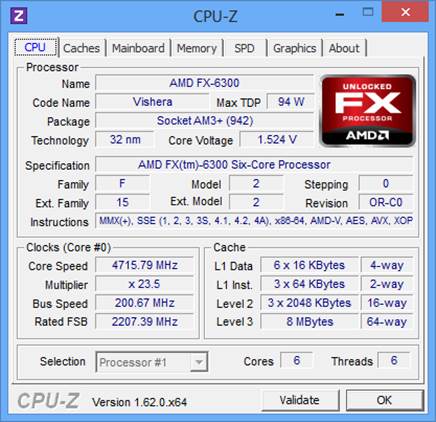
FX-6300
remained perfectly stable at the maximum 4.7GHz frequency
We were very optimistic about AMD FX-4300
overclocking, because some sources reported it could hit the 5GHz mark with
these CPUs, however, we couldn’t clarify their reports. Our particular
processor with half of the active cores and only half of the L3 cache remained
stable at Vishera’s typical max frequency (4.6 GHz), with no gambling at
potentially dangerous Vcore levels, at least.
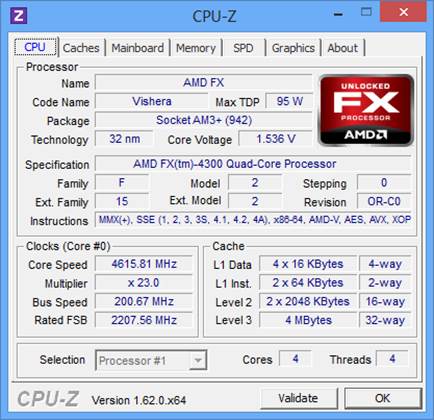
Some
sources reported AMD FX-4300 could hit the 5GHz mark
After all above, it seems that all FX
processors on Piledriver microarchitecture plus independent of the number of
cores they have, are able to overclock to about the same level of 4.6-4.7GHz
with air-cooling. Well, it is better than what we saw from AMD FX’s
previous-generation processors, but there is surely no improvement in quality
in their frequency potential as mentioned. Though, over-clockers should be quite
happy with these results, quite typical for 32nm processors.
I would like to mention that when we
overclocked FX-6300 and FX-4300 processors by raising their Vcore to 1.5-1.55V,
their temperature didn’t rise too much. Our six-core CPU’s temperature rose to
65°C maximum, while the quad-core temperature stayed at the low 53°C record. It
means that you could raise the core voltage higher and achieve stability at
even higher clock speeds. However, we cannot agree on this approach, because
excessive increase in the processor’s Vcore may result in die degradation and hence
this mode is unacceptable for long-term use.